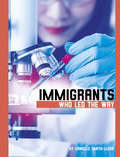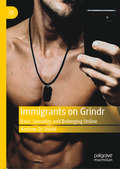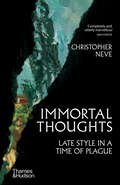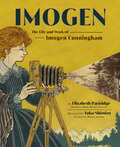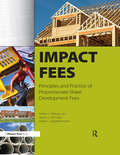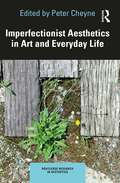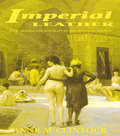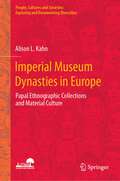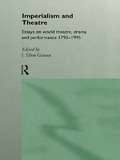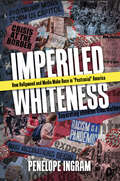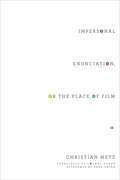- Table View
- List View
Immigrants Who Led the Way (Immigrants Who Dared)
by Danielle Smith-LleraSome of the most important American products and ideas have been developed by people born outside the United States. They have influenced every part of U.S. culture, from what people wear and drive to how they stay healthy, how they communicate with each other, and what they do for fun. Meet 25 immigrants who have led the way with life-saving inventions, by opening up sports to women and people of color, and so much more.
Immigrants on Grindr: Race, Sexuality and Belonging Online
by Andrew DJ ShieldThis book examines the role of hook-up apps in the lives of gay, bi, trans, and queer immigrants and refugees, and how the online culture of these platforms promotes belonging or exclusion. Within the context of the so-called European refugee crisis, this research focuses on the experiences of immigrants from especially Muslim-majority countries to the greater Copenhagen area, a region known for both its progressive ideologies and its anti-immigrant practices. Grindr and similar platforms connect newcomers with not only dates and sex, but also friends, roommates and other logistical contacts. But these socio-sexual platforms also become spaces of racialization and othering. Weaving together analyses of real Grindr profile texts, immigrant narratives, political rhetoric, and popular media, Immigrants on Grindr provides an in-depth look at the complex interplay between online and offline cultures, and between technology and society.
Immortal Films: "Casablanca" and the Afterlife of a Hollywood Classic
by Barbara KlingerCasablanca is one of the most celebrated Hollywood films of all time, its iconic romance enshrined in collective memory across generations. Drawing from archival materials, industry trade journals, and cultural commentary, Barbara Klinger explores the history of Casablanca's circulation in the United States from the early 1940s to the present by examining its exhibition via radio, repertory houses, television, and video. By resituating the film in the dynamically changing industrial, technological, and cultural circumstances that have defined its journey over eight decades, Klinger challenges our understanding of its meaning and reputation as both a Hollywood classic and a cult film. Through this single-film survey, Immortal Films proposes a new approach to the study of film history and aesthetics and, more broadly, to cinema itself as a medium in constant interface with other media as a necessary condition of its own public existence and endurance.
Immortal Thoughts: Late Style In A Time Of Plague
by Christopher NeveA remarkable, heartfelt, beautifully written analysis of the late work of major artists which author Max Porter has called “completely and utterly marvelous.” In 2020, as the spread of COVID-19 caused pandemonium worldwide,a painter and writer returned to a childhood home to reflect upon the transcendence of nature and the work of the artists he most admires. It seems to Christopher Neve that in their final works—their late style—that they have something remarkable in common. This has more to do with intuition and memory than with rationality or reason. Immortal Thoughts: Late Style in a Time of Plague is an anthology of these reflections. In this personal and moving account, nineteen short essays on artists are interspersed with recollections of the cataclysmic global progress of the disease in poignant contrast to the beauty of the seasons in Neve’s isolated house and garden. From Paul Cézanne and Michelangelo to Rembrandt and Gwen John, Neve dwells on artists’ late ideas, memories, risks, and places in the context of time and mortality. As much art history as a discussion of great art in the context of the “dance of death,” Neve also writes about Pierre Bonnard, Giorgio Morandi, Nicolas Poussin, Chaim Soutine, and many others. Immortal Thoughts is a summary of a lifetime’s contemplation of art.
Immortali a Mosca
by Elena ČernikovaRomanzo-avventura. La famiglia Užov si è contagiata con l'immortalità. Comincia un'epidemia. Ognuno riceve secondo i meriti...
Immortality in Moscow
by Elena ChernikovaThe novel describes the extraordinary adventures of people and animals infected with immortality.
Imogen: The Life and Work of Imogen Cunningham
by Elizabeth PartridgeA picture book biography of the iconic photographer Imogen Cunningham by National Book Award finalist Elizabeth Partridge.Imogen Cunningham loved to observe the world. She noticed the colors in the woods outside her house and how light and shadows moved between the trees. She tried to capture this beauty on paper with pencils, but something was missing. One day she read about a woman in Paris who earned a living as a photographer, and she knew she was meant to do the same. With the support of her loving father, she then began her journey to become one of the most important photographers in America.The life of iconic photographer Imogen Cunningham is brought vividly to life by National Book Award finalist Elizabeth Partridge, who also happens to be Cunningham&’s granddaughter. With stunning illustrations by Caldecott Honor winner Yuko Shimizu, Imogen captures the passion of the creative process with a unique and intimate perspective.
Impact Fees: Principles and Practice of Proportionate-Share Development Fees
by Author C NelsonThis is the only impact fee book you'll need for the next decade or longer! This comprehensive reference book updates the popular, pioneering works on impact fees by introducing new methodologies, concepts, applications, and theories. The authors contend that it's time to go beyond narrowly defined impact fees to proportionate-share development fees broadly applied to publicly provided facilities and services and their operation. Impact fees are one-time charges applied to new development to generate revenue for the construction or expansion of capital facilities outside the boundaries of the new development for system improvements engendered by the new development. At least that was the traditional use of impact fees. A generation ago, they were generally not used legally for the operation, maintenance, repair, alteration, or replacement of capital facilities; for social purposes such as affordable housing and daycare; or for "green" purposes such as habitat preservation. This book updates impact fee law, practice, and applications, and breaks new ground by showing how the impact fee logic of proportionate share can be used for these and other purposes. Through actual ordinances, summaries of technical reports, numerous case studies, and model ordinances and codes, readers will learn how to design and implement a proportionate-share development fee program. This is essential reading for anyone interested in impact fees.
Impact: A Complete Guide to Creating a User Research Practice at Your Organization
by Nikki AndersonEmbark on a transformative journey into the world of user research with Impact by Nikki Anderson. In the realm of product creation, understanding your users is the cornerstone of building life-changing products. This comprehensive guide is your key to establishing a robust user research practice within your organization, ensuring that decisions are rooted in empathy, understanding, and a deep connection with your audience.Impact goes beyond the surface of having a great idea; it delves into the intricacies of creating competent, passionate, and skillful teams. Nikki Anderson, drawing from her wealth of experience, provides invaluable insights into setting up a research practice that becomes an indispensable resource for your colleagues. This book is not just a guide; it’s a thought partner, offering a step-by-step approach to navigate the complexities of establishing a research practice, making it accessible even for those new to the field.
Impact: Proceedings of the Design Modelling Symposium, Berlin 2019
by Christoph Gengnagel Jane Burry Mette Ramsgaard Thomsen Stefan Weinzierl Olivier BaverelThis book reflects and expands on the current trend in the building industry to understand, simulate and ultimately design buildings by taking into consideration the interlinked elements and forces that act on them. Shifting away from the traditional focus, which was exclusively on building tasks, this approach presents new challenges in all areas of the industry, from material and structural to the urban scale. The book presents contributions including research papers and case studies, providing a comprehensive overview of the field as well as perspectives from related disciplines, such as computer science. The chapter authors were invited speakers at the 7th Symposium “Impact: Design With All Senses”, which took place at the University of the Arts in Berlin in September 2019.
Impacting Theatre Audiences: Methods for Studying Change (Audience Research)
by Dani Snyder-Young Matt OmastaThis edited collection explores methods for conducting critical empirical research examining the potential impacts of theatrical events on audience members. Dani Snyder-Young and Matt Omasta present an overview of the burgeoning subfield of audience studies in theatre and performance studies, followed by an introduction to the wide range of ways scholars can study the experiences of spectators. Consisting of chapter length case studies, the book addresses methodologies for examining spectatorship, including qualitative, quantitative, historical/historiographic, arts-based, participatory, and mixed methods approaches. This volume will be of great interest to theatre and performance studies scholars as well as industry professionals working in marketing, audience development and community engagement.
Impacts of Climate Change on Vernacular Landscapes and Cultural Heritage (Routledge Explorations in Environmental Studies)
by Gül AktürkThis book reveals the impacts of climate change and anthropogenic interventions on vernacular landscapes as a cultural heritage through an analysis of regional and urban development projects and local-level practices. Vernacular landscapes encompass customs, practices, places, objects, artistic expressions, and values that are innate to a particular place and time, with climate knowledge embedded alongside other environmental, cultural, and societal determinants. The cultural heritage of these places is threatened by climate and disaster risks, such as loss of land, food sources, water resources, intangible values, and displacement.This book first critically unfolds the legacy of vernacular heritage responses to local conditions, focusing on climate, drawing on the examples of vernacular heritage sites worldwide, including India, Japan, and Mali. It then critically analyses the effects of climate and disaster risks on vernacular heritage, accelerated by spatial and local decisions and practices in a detailed study in Fındıklı, a district of Rize Province on the Black Sea coast in Turkey. It evaluates the insights, perceptions, and experiences of local people through interviews aiming to shed light on climate-resilient vernacular heritage sites.By understanding the present challenges resulting from past decisions and actions at various scales, this book offers an interdisciplinary approach to the emerging field of climate change adaptation of cultural heritage studies. Bridging multiple fields, it will be of interest to researchers, academics, and students interested in cultural heritage, climate change studies, environmental studies, architectural and landscape conservation, and planning.The Open Access version of this book, available at www.taylorfrancis.com, has been made available under a Creative Commons Attribution-Non-Commercial-No Derivative Licence (CC-BY-NC-ND) 4.0 International license.Any third party material in this book is not included in the OA Creative Commons license, unless indicated otherwise in a credit line to the material. Please direct any permissions enquiries to the original rightsholder.
Impacts of European Territorial Policies in the Baltic States
by Garri Raagmaa and Dominic SteadUrban and regional development in the Baltic States and other Central and Eastern European countries has experienced rapid changes since their re-independence at the beginning of the 1990s. Meanwhile, urban and regional planning institutions and organizational cultures in the Baltic States have only changed rather incrementally, despite various national and European pressures for reform. As a consequence, the effects of European cohesion and structural policy measures have been quite modest, and the ability of the planning systems in the Baltic states to manage contemporary trends in urban and regional development has become increasingly limited. This book focuses on these issues and tensions of spatial planning and development in the Baltic States and their distinctiveness compared to other European countries. It provides an overview of the historical and cultural context of spatial development, a discussion of the processes of Europeanization of spatial planning in the specific context of the Baltic States, and an analysis of whether these processes may be leading to policy convergence in the region.This book was published as a special issue of European Planning Studies.
Impacts of Using Biomass as an Energy Source in Homes (Green Energy and Technology)
by Allana Katiussya Silva Pereira Ananias Francisco Dias JúniorThe book deepens understanding of biomass sources and technologies used for cooking worldwide. It contributes directly to the creation of policies aimed at the mitigation of climate change.Historically, wood is considered humanity's first source of energy. Even after decades of use and industrialization processes, it is still considered the most important single source of renewable energy. About a third of the world's population is energetically dependent on wood for cooking and/or heating. Recently, the Covid-19 pandemic made it impossible to purchase fuels such as liquefied petroleum gas (LPG), forcing families in financial difficulties to opt for cheaper and more accessible sources of energy, such as wood and vegetable coal. This has been the picture of many families around the world and negatively impacts the environment and energy security. Considering that there are still many wood residues that are wasted and that tropical forests need to be conserved, knowledge about the energy use of wood residues is also essential. This is even more relevant when considering the significant volume of biomass coming from the sustainable management of the largest tropical forest in the world, the Amazon Forest.The book considers which wood variables should be taken into account when thinking about energy generation, how do food cooking technologies contribute to potentiating pollutants emissions, and how can these harmful effects be mitigated. It describes the chemical composition of biomass and the chemical compounds released during its burning, as well as their impacts on the environment and human health. It also presents the influence that technologies used in food cooking have on pollutant emissions and which alternatives can be used, such as the use of solar energy.
Imperfectionist Aesthetics in Art and Everyday Life (Routledge Research in Aesthetics)
by Peter CheyneThis book presents interdisciplinary research on the aesthetics of perfection and imperfection. Broadening this growing field, it connects the aesthetics of imperfection with issues in areas including philosophy, music, literature, urban environment, architecture, art theory, and cultural studies. The contributors to this volume argue that imperfection has value in being open and inclusive. The aesthetics of imperfection is typified by organic, unpolished production and the avoidance of perfect finish, instead representing living and natural change, and opposing the consumerist concern with the flawless and pristine. The chapters are divided into seven thematic sections. After the first section, on imperfection across the arts and culture, the next three parts are on imperfection in the arts of music, visual and theatrical arts, and literature. The second half of this book then moves to categories in everyday life and branches this further into body, self, and the person, and urban environments. Together, the chapters promote a positive ethos of imperfection that furthers individual and social engagement and supports creativity over mere passivity. Imperfectionist Aesthetics in Art and Everyday Life will appeal to a broad range of scholars and advanced students working in philosophical aesthetics, literature, music, urban environment, architecture, art theory, and cultural studies.
Imperial Affects: Sensational Melodrama and the Attractions of American Cinema
by Jonna EagleImperial Affects is the first sustained account of American action-based cinema as melodrama. From the earliest war films through the Hollywood Western and the late-century action cinema, imperialist violence and mobility have been produced as sites of both visceral pleasure and moral virtue. Suffering and omnipotence operate as twinned affects in this context, inviting identification with an American national subject constituted as both victimized and invincible—a powerful and persistent conjunction traced here across a century of cinema.
Imperial Leather: Race, Gender, and Sexuality in the Colonial Contest
by Anne McclintockImperial Leather chronicles the dangerous liaisons between gender, race and class that shaped British imperialism and its bloody dismantling. Spanning the century between Victorian Britain and the current struggle for power in South Africa, the book takes up the complex relationships between race and sexuality, fetishism and money, gender and violence, domesticity and the imperial market, and the gendering of nationalism within the zones of imperial and anti-imperial power.
Imperial Museum Dynasties in Europe: Papal Ethnographic Collections and Material Culture (People, Cultures and Societies: Exploring and Documenting Diversities)
by Alison L. KahnThis book reveals the history of the Vatican’s ethnographic collections by exploring the imperial, scientific, technological, and religious agendas behind its collecting and curating practices in the early twentieth century. It focuses on two principal contributors: the academic, priest, and ‘Pope’s Curator’, Father Wilhelm Schmidt, SVD, and the missionary and linguist, Father Franz Kirschbaum, SVD. Their narratives are embedded in a unique set of comparisons between the ‘liberal humanist ideals’ that underpinned the 1851 Great Exhibition, mid-nineteenth-century German museology, and the 1925 Pontifical Missionary Exhibition. It relates to the period of high colonialism and rampant missionary activity worldwide. It unravels the complicated political and ideological stance taken by the Catholic Church and its place within the science/religion debates of its time. Establishing an essential link between the secular and catholic practices of collecting and curating ethnographic objects from non-Western traditions, the author proposes a broader framework for post-colonial approaches to scholarly studies of ethnographic collections, including those of the Catholic Church. This book appeals to students and scholars of anthropology, museum studies, history, art history, religion, politics, and cultural studies.
Imperial Romance: Fictions of Colonial Intimacy in Korea, 1905–1945
by Su Yun KimIn Imperial Romance, Su Yun Kim argues that the idea of colonial intimacy within the Japanese empire of the early twentieth century had a far broader and more popular influence on discourse makers, social leaders, and intellectuals than previously understood. Kim investigates representations of Korean-Japanese intimate and familial relationships—including romance, marriage, and kinship—in literature, media, and cinema, alongside documents that discuss colonial policies during the Japanese protectorate period and colonial rule in Korea (1905–45). Focusing on Korean perspectives, Kim uncovers political meaning in the representation of intimacy and emotion between Koreans and Japanese portrayed in print media and films. Imperial Romance disrupts the conventional reading of colonial-period texts as the result of either coercion or the disavowal of colonialism, thereby expanding our understanding of colonial writing practices. The theme of intermarriage gave elite Korean writers and cultural producers opportunities to question their complicity with imperialism. Their fictions challenged expected colonial boundaries, creating tensions in identity and hierarchy, and also in narratives of the linear developmental trajectory of modernity. Examining a broad range of writings and films from this period, Imperial Romance maps the colonized subjects' fascination with their colonizers and with moments that allowed them to become active participants in and agents of Japanese and global imperialism.
Imperial Spoils: The Curious Case of the Elgin Marbles
by Robert Browning Christipher Hitchens Graham BinnsThomas Bruce, British ambassador to the Ottoman Empire and 7th Earl of Elgin, gave friezes from the Parthenon to the British Museum, sparking a controversy about the Elgin Marbles. Should they be returned to Greece?
Imperial Stewards: Chinese Art and the Making of America’s Pacific Century (Asian America)
by K. Ian ShinFrom the Gilded Age to World War II, elite collectors and museums in the United States transformed from owning a smattering of Chinese porcelain as curios to possessing some of the world's largest and most sophisticated collections of Chinese art. Imperial Stewards argues that, beyond aesthetic taste and economics, geopolitics were critical to this transformation. Collecting and studying Chinese art and antiquities honed Americans' belief that they should dominate Asia and the Pacific Ocean through the ideology of imperial stewardship—a view that encompassed both genuine curiosity and care for Chinese art, and the enduring structures of domination and othering that underpinned the burgeoning transpacific art market. Tracing networks across both the Pacific and the Atlantic Oceans, K. Ian Shin uncovers a diverse cast of historical actors that both contributed to US imperial stewardship and also challenged it, including Protestant missionaries, German diplomats, Chinese-Hawaiian merchants, and Chinese overseas students, among others. By examining the development of Chinese art collecting and scholarship in the United States around the turn of the twentieth century, Imperial Stewards reveals both the cultural impetus behind Americans' long-standing aspirations for a Pacific Century and a way to understand—and critique—the duality of US imperial power around the globe.
Imperial Ventures: Maritime Drama and the Invention of Risk
by Benjamin VanWagonerLinks early modern English drama and empire studies, exploring how staged scenes of maritime peril created a new form of economic uncertaintyImperial Ventures links early modern English drama and empire studies, exploring how staged scenes of maritime peril created a new form of economic uncertainty around the turn of the seventeenth century, amid London’s explosion in commercial colonialism.While the hazards of global maritime trade became increasingly apparent during the late sixteenth and early seventeenth centuries, the word “risk” did not enter English usage until around 1660. The prevailing scholarly narrative has linked uncertainty to concepts such as “chance,” “accident,” and “providence,” but this book reveals that these fragmentary concepts were reordered into an economic abstraction, and that the theater was a key site for that process. Playwrights reached for ways to represent this new uncertainty, and audiences watched perilous voyages set in colonial contexts and dramatized in increasingly typical forms. Imperial Ventures is organized by these forms, with five chapters examining scenes of shipwreck, pirates, enslavement, colonial subjection, and perilous news across a wide range of early modern plays.Benjamin VanWagoner shows how maritime drama connected English venturing to economic vulnerability in increasingly systematic ways, helping to develop the economic logic that would come to be codified as risk. In revealing this process, Imperial Ventures establishes the unique protocolonial status of early modern England—in the theater and at sea—and demonstrates how risk became a perverse instrument for justifying Anglophone imperialism.
Imperialism and Theatre: Essays On World Theatre, Drama, And Performance
by J. Ellen GainorImperialism is a transnational and transhistorical phenomenon; it occurs neither in limited areas nor at one specific moment. In cultures from across the world theatrical performance has long been a site for both the representation and support of imperialism, and resistance and rebellion against it. Imperialism and Theatre is a groundbreaking collection which explores the questions of why and how the theatre was selected within imperial cultures for the representation of the concerns of both the colonizers and the colonized. Gathering together fifteen noted scholars and theatre practitioners, this collection spans global and historical boundaries and presents a uniquely comprehensive study of post-colonial drama. The essays engage in current theoretical issues while shifting the focus from the printed text to theatre as a cultural formation and locus of political force. A compelling and extremely timely work, Imperialism and Theatre reveals fascinating new dimensions to the post-colonial debate. Contributors: Nora Alter; Sudipto Chatterjee; Mary Karen Dahl; Alan Filewood; Donald H. Frischmann; Rhonda Garelick; Helen Gilbert; Michael Hays; Loren Kruger; Josephine Lee; Robert Eric Livingston; Julie S. Peters; Michael Quinn; Edward Said; Elaine Savory.
Imperiled Whiteness: How Hollywood and Media Make Race in "Postracial" America
by Penelope IngramIn Imperiled Whiteness, Penelope Ingram examines the role played by media in the resurgence of white nationalism and neo-Nazi movements in the Obama-to-Trump era. As politicians on the right stoked anxieties about whites “losing ground” and “being left behind,” media platforms turned whiteness into a commodity that was packaged and disseminated to a white populace. Reading popular film and television franchises (Planet of the Apes, Star Trek, and The Walking Dead) through political flashpoints, such as debates over immigration reform, gun control, and Black Lives Matter protests, Ingram reveals how media cultivated feelings of white vulnerability and loss among white consumers. By exploring the convergence of entertainment, news, and social media in a digital networked environment, Ingram demonstrates how media’s renewed attention to “imperiled whiteness” enabled and sanctioned the return of overt white supremacy exhibited by alt-right groups in the “Unite the Right” rally in Charlottesville in 2017 and the Capitol riots in 2021.
Impersonal Enunciation, or the Place of Film
by Dana Polan Cormac Deane Christian MetzChristian Metz is best known for applying Saussurean theories of semiology to film analysis. In the 1970s, he used Sigmund Freud's psychology and Jacques Lacan's mirror theory to explain the popularity of cinema. In this final book, Metz uses the concept of enunciation to articulate how films "speak" and explore where this communication occurs, offering critical direction for theorists who struggle with the phenomena of new media. If a film frame contains another frame, which frame do we emphasize? And should we consider this staging an impersonal act of enunciation? Consulting a range of genres and national trends, Metz builds a novel theory around the placement and subjectivity of screens within screens, which pulls in-and forces him to reassess-his work on authorship, film language, and the position of the spectator. Metz again takes up the linguistic and theoretical work of Benveniste, Genette, Casetti, and Bordwell, drawing surprising conclusions that presage current writings on digital media. Metz's analysis enriches work on cybernetic emergence, self-assembly, self-reference, hypertext, and texts that self-produce in such a way that the human element disappears. A critical introduction by Cormac Deane bolsters the connection between Metz's findings and nascent digital-media theory, emphasizing Metz's keen awareness of the methodological and philosophical concerns we wrestle with today.
